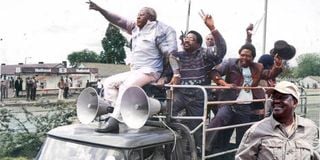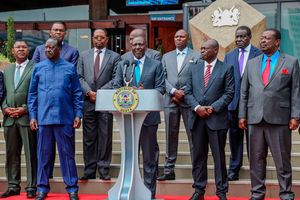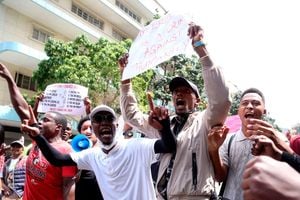
Opposition leaders heading to Kamukunji Grounds July 7, 1990. (inset) Azimio leader Raila Odinga.
The country had been treated to months of violent clashes between opposition supporters and the police in the 1990s, mirroring the Gen Z-led protests that have snowballed into a crisis for President Ruto’s administration.
From January 1990 to December 1991, the struggle for multi-party democracy degenerated into bloody confrontations as an unyielding Kanu regime of President Moi faced-off with opposition supporters.
Weeks into the protests against unpopular tax increases and runaway cost of living, President Ruto has been forced to withdraw the Finance Bill, 2024, but the confrontation continues.
The President has since called an opposition leader Raila Odinga-backed, six-day, 1,500-person multi-sectoral discussion, beginning Monday next week.
Of the 1,500 panel, President Ruto said, 500 will comprise the youth. State agents have been accused of sponsoring goons to cause violence to try and discredit the youth movement that has held largely peaceful demonstrations, and which is pressing on with the push for better governance and sound economic policies.
The push for multi-party politics had culminated in a public rally in Nairobi’s Kamukunji grounds on July 7, 1990, famously known as Saba Saba.
Opposition luminaries, including Kenneth Matiba, Charles Rubia and Raila Odinga said the forum was to seek the views of ordinary Kenyans.
The trio would be arrested and detained without trial and on Saba Saba D-day, defiant crowds took to the streets, forcing police to open fire. At least 39 people were killed, thousands injured and scores of others arrested and charged.
More protests
Sixteen months later, following more protests and agitations that also involved leaders such as James Orengo, Martin Shikuku and some fiery clerics like Timothy Njoya and Henry Okullu, coupled with international pressure, President Moi gave in.
Against the advice of Kanu stalwarts, he agreed to the repeal of Section 2A of the Constitution and multi-partyism was reintroduced. Threatened by the 1982 abortive coup, Moi had abolished multi-party politics and tightened his grip on power.
Former Cabinet Minister Sam Ongeri, who was appointed by President Moi to oversee Technical Training and Applied Technology after his first parliamentary election in 1988, remembers a noticeable sense of siege in the government in the subsequent years.
Prof Ongeri recalls that, at the height of the clamour for multi-party in 1991, the international community had piled pressure on the government through donor funding freeze.
“In 1991 we had a crunch meeting with the Bretton Woods institutions; World Bank and IMF. They refused to give credit to Kenya and money was not flowing to aid government operations,” Prof Ongeri told the Nation in a recent interview.
Prof Ongeri recalls that President Moi was forced to establish the Kanu Review Committee to recommend changes to the party's structure and policies in the face of mounting pressure for political reform and the transition to a multiparty system.
“The committee's work was significant as Kenya navigated the political shift towards multiparty democracy, and the recommendations made by this committee that was chaired by vice president George Saitoti and deputised by myself played a role in how the ruling party adjusted to the new political landscape,” Prof Ongeri recollects.
Amid heightened opposition to multi-partyism within Kanu, including in the Moi Cabinet, Prof Ongeri says the reforms were non-negotiable.
“It was quite clear to us that Kenyans wanted multi-partism. When we told president Moi that this is what Kenyans wanted, jokingly he said; “nyinyi wasomi hamjui” (You elites do not understand). I'm going to call a governing council of the party to deliberate on this matter further,” Prof Ongeri recalls Moi’s position on their report. The president later convened a Governing Council meeting and a delegates’ convention at the Kasarani Sports Complex on December 3, 1991.
“Speaker after speaker spoke tough against the multi-party system amid applause from Kanu delegates. For a moment Saitoti and myself, among other committee members, felt the heat. We knew our goose had been cooked for tabling an unpopular report in the cabinet and to the Kanu delegates,” Prof Ongeri recalls the events of the historic day.
“Moi was looking at us and laughing…as we were walking for lunch, we told Mzee to reconsider this. But he said; ‘Don't you see what the people are saying?’ I told Mzee... Yes, they may be saying that here but on the ground, things are different.”
After the lunch session, more defiant speeches against pluralism continued amid applause from the delegates.
“When Moi stood to speak, the mood was very clear that delegates were on the verge of denouncing reintroduction of multi-party politics,” Prof Ongeri narrates.
“He said, ‘I agree with you that Kanu is very strong and indeed baba na mama (father and mother of parties). You cannot change Kanu because we are such a mass movement. Therefore, we will stick to Kanu, but when you look at the skies and see clouds, that’s a sign that it is going to rain. Let us accept it but stick to Kanu and Kanu will continue to rule for 100 years,” Prof Ongeri recounts the president telling the delegates.
There was a moment of silence in the arena.
“We realised that Moi had only wanted to get as many views as possible before finally making a decision. The delegates had now changed and started cheering Moi for accepting the report for the repeal of Section 2A which had made Kenya a de facto one-party state under the ruling party, Kanu,” Prof Ongeri says.
“The sycophants had a terrible day and we had our way,” he adds. Former National Assembly Speaker Francis Ole Kaparo in his new book “Calming the Storms” launched in April, recalls the tense day at the Kasarani Sports Complex. “On the first morning of the conference I had watched in dismay as sycophants fell over themselves, urging the Head of State not to heed the call of those calling for plurality in Kenya, and to ignore the pressure piled on him by the West,” Mr Kaparo says in his book.
Delegates at the conference, Mr Kaparo recounts, urged the Head of State to ignore the proponents of multi-party.
Mr Kaparo who at that time was serving as the assistant minister for Labour, recalls that on the second day of the conference, he had a chance to address the gathering – just briefly.
Ruling party
“The poignancy of my words ensured that I was to be the first and last speaker of that fateful day. After paying the necessary homage to the strengths and virtues of the ruling party, I urged the Head of State to let us face our detractors, as I was certain we would vanquish them at the polls and outplay them in the National Assembly.”
“As soon as I was done speaking, President Moi stood up and adjourned the meeting. It was the loneliest adjournment I have ever had to endure.”
However, it was Job Moika Kasaine Lelampaa, the Samburu East MP, who captured the mood of the moment. He edged to where I stood alone and said: “I think you were misquoted."
"I can't misquote myself!" I curtly replied.
He says he got a sigh of relief when president Moi later conceded to multi-party.
“At that moment, you could hear the drop of a feather. The President explained that he did not want Kenyans to continue suffering under punishing sanctions on account of a single party state. He was ultimately liberating Kenya!”
The moment he finished speaking, Mr Kaparo adds in his book, those who had urged him to clamp down on dissension clapped and tripped over themselves to congratulate him.
“I don't know what he thought of this circus of foolishness, but I couldn't help but wonder about the clowning. How could men and women who had – barely a day earlier - urged one position, switch so casually to another so shamelessly? It was embarrassing.”
“The President never called to talk or congratulate me for the bravery I displayed at Kasarani, but I knew that he greatly appreciated my role, because three days after that event, he appointed me the Minister for Industry.”
He says that would later open his ways of becoming the fifth Speaker of the National Assembly.
On Christmas day – December 25, 1991, barely three weeks after the repeal of Section 2A, Prof Ongeri recalls that Mwai Kibaki and John Keen would announce formation of the Democratic Party of Kenya (DP) on whose ticket the former vice president contested against Moi in the 1992 presidential elections.
“He had been so attached to Kanu that he never imagined leaving the party and even as we struggled to convince Moi to accept multi-party, he was on the other side but now see, he was the immediate beneficiary of the multi-party,” Prof Ongeri says.
“Maybe he had agreed with us silently but simply wanted to carry along the delegates who were opposed to multi-party.”







